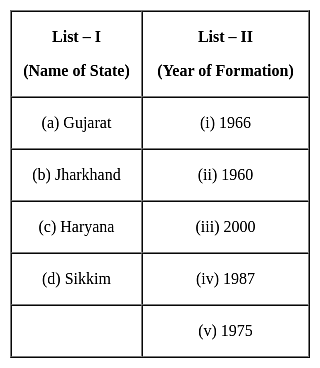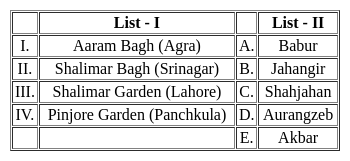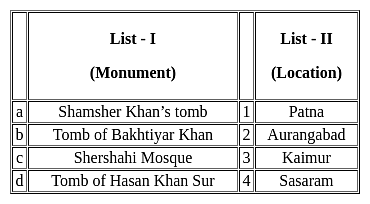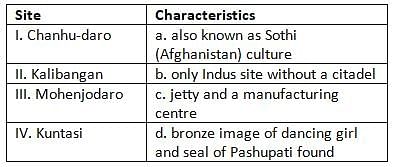APSET Paper 2 Mock Test - 8 (History) - AP TET MCQ
30 Questions MCQ Test APSET Mock Test Series 2025 - APSET Paper 2 Mock Test - 8 (History)
Among the followings the author of the text ‘Khanda Khaddhak’ is-
| 1 Crore+ students have signed up on EduRev. Have you? Download the App |
Gandhara School of art is related to which of the following dynasties?
Consider the following statements with regard to Kakatiyas and select correct statements:
(A) Agriculture was the main profession during Lakatiya rule
(B) Forests cleared and new areas were brought under cultivation
(C) Land Revenue was collected both in cash and kind.
(D) Irrigation was not given importance.
Which among the following is NOT a correct statement in context with the Gupta Era?
Consider the following statements about the bhakti movement in South India.
1. The doctrine of bhakti was concentrated only among the rural sections of society.
2. The Bhakti saints opposed the varna system which led to the weakening of casteism.
Which of the above statements is/are correct?Which of the following characterize or characterizes the town planning of the Harappan Civilization?
1. They possessed great palaces and temples.
2. The use of burnt bricks in the Harappan cities is remarkable.
3. The Drainage System of the Harappan Civilization was poor.
Which of the statements given above is/are correct?
Consider the following statements about the “Prajapatya Vivaha” mentioned in ancient Indian texts:
- In this type of marriage, the rights of boy and girl were equally secured
- The groom approached the bride’s father, who agreed to marriage after fixing a price
- The price for this marriage was usually a pair of cows
Which among the above statements is/ are correct?
Consider the following statements with reference to the poetry tradition of Indian history:
1. The Samhitas are a compilation of hymns, prayers and archetypal poetry.
2. Malatibhava, written by Kalidasa, is a part of Early Sanskrit literature.
3. In Sangam literature, while Ettutogai is a collection of eight anthologies of poems, Pathupattu is a collection of ten long poems.
4. Under Telugu literature, song literature called pattu flourished.
Which of the above statements is/are correct?
Which of the following statements are correct?
1. The EIC lost monopoly of trade with the Charter of 1813.
2. The use of Indian ships for trade was banned.
3. It was made obligatory for the British Government to purchase only British-made paper for use in India.
4. Measures such as 2 and 3 ultimately ruined Indian industries.
Match List-I with List-II and select the correct answer using the codes given below the lists:

Which of the following statements about the agrarian structure of the Gupta period are true?
(i) In the first half of the Gupta period, the king or the state claimed theoretical ownership of the land, though in practice the peasants had ownership rights.
(ii) The Poona Copper Plate of Prabhavatigupta provides us sufficient evidence for land survey during the Gupta period.
(iii) An officer called Pustapala was in charge of land revenue collection at the district level.
(iv) The Gupta inscriptions from Bengal and Bihar authorise the grantees to make a further gift of their lands to others.
(v) The Gupta land grants in central India and western India give not only fiscal rights but also rights of judicial administration to the recipients.
Select the answer from the codes given below:
Consider the following statements :
1. Tanjore was capital of Cholas.
2. The founder of the Chola dynasty was Aditya I.
Which of the statement(s) given above is/are incorrect?
The Four Noble Truths are a central theme in the Buddhism. Which among the following statements conform to the Four Noble Truths?
- To live is to suffer
- Origin of suffering is attached to desire
- Individualism contributes to suffering
Select the correct option from the codes given below:
What was the immediate reason for the Second Carnatic War?
Here is a list of wars which were fought in India during the medieval times :
i) Deorai
ii) Dharmat
iii) Samugarh
iv) Samel
Their chronological order is-
List-I denotes the Mughal Gardens and List-II denotes the rulers under whose reign the Gardens were built. Match the two lists correctly.

Choose the correct code:
Who among the following were supported by Dupleix during the Second Carnatic War?
- Nasir Jang
- Muzaffar Jang
- Anwar-Ud-Din
- Chanda Sahib
Choose the correct option from the codes given below :
Gandhiji’s' ideology, best articulated in his seminal work, “Hind Swaraj” written in 1909, expounds that
1. Industrial capitalism was held responsible for all conflicts of interests, for it divorced economic activities from moral concerns.
2. The ancient Indian civilization "unquestionably the best", was the fountainhead of Indian nationality, as it had immense assimilative power of absorbing foreigners of different creeds.
3. Parliamentary Democracy did not reflect the general will of the people, but of the political parties.
Which of the above statements is/are correct?
Industrial bourgeoisie took stand to expand political control for:
Which of the following text was found in the Aryan expansion of 6th and 7th centuries BC?
Which of the following plains became the pirot for Aryan Civilisation?
Which of the following statement best summarises the nature of 1857 revolt?
Consider the following statements about the Government of India Act 1935:
- The membership of Central Legislative Assembly and the Council of State was increased
- Provincial autonomy was introduced into the provinces
- The Dyarchy system was transferred from provinces to the centre.
Which of the above statements is/are correct?
Consider the following statements about Ashokan Edicts:
- All Ashokan edicts are written in Prakrit language
- Devanagari script was the most common script used for all writings
Which of the above statements is/are correct?
Below given are two statements, one is labelled as Assertion (A) and the other as Reason (R):
Assertion (A): Mughal painters who migrated to the Deccan during the period of Aurangzeb were responsible for the development of various other centres of paintings in Deccan, such as Hyderabad.
Reason (R): The Deccani school of painting developed under the influence of the Mughal style from the beginning.
Select the correct answer using the codes given below:
|
60 tests
|




















